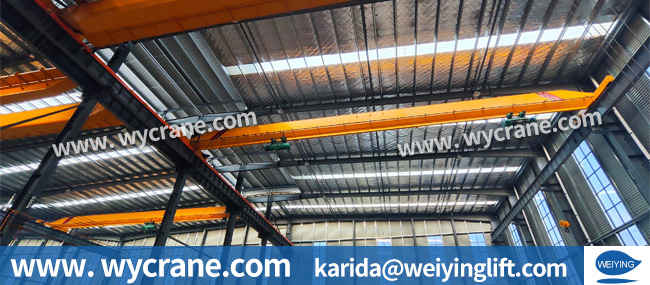An overhead crane, also known as an “ bridge crane” or “traveling crane“, is based on elevated rails on both sides of a factory building. It operates in coordination with a longitudinal main trolley, a transverse auxiliary trolley, and a vertical hoisting mechanism, enabling precise three-dimensional displacement of heavy loads within the covered rectangular space. Its rated lifting capacity ranges from 1 ton to thousands of tons, and it is widely used in various industrial fields. Its core purposes can be systematically categorized as follows:

This is its most fundamental function. It replaces the primitive, inefficient, and high-risk manual handling, enabling fast and safe movement of materials in workshops, warehouses, and storage yards.
In modern high-end manufacturing, the role of overhead bridge cranes goes far beyond handling. With millimetric or even higher positioning accuracy and micro-speed lifting functions, they can accurately align and install huge components weighing hundreds of tons.
By equipping with various specialized lifting tools (such as C-hooks, vacuum suction cups, electromagnetic discs, and rotating hooks), it can complete complex operations such as 180° horizontal flipping of workpieces, 90° vertical turning of workpieces, and tilting and pouring of large containers (e.g., molten steel ladles).
Fields: Automobile manufacturing, heavy machinery, machine tool equipment, pressure vessels.
Purposes: In automobile factories, it is responsible for the aerial transportation of car body assemblies and the rapid replacement of large stamping dies. In machine tool manufacturing, a precision crane can hoist a machine tool bed weighing dozens of tons into place in one lift, significantly improving production efficiency.
Purposes: Specialized metallurgical cranes can operate stably in harsh environments with high temperatures (nearly 1,000°C), high dust levels, and high corrosion. They are equipped with fully enclosed heat-resistant bridges, high-temperature-resistant steel wire ropes, forced cooling systems, and redundant safety braking systems to provide reliable guarantees for safe production.
Fields: Hydropower generation, thermal power generation, nuclear power generation, wind power generation.
Purposes: In hydropower stations and nuclear power plants, overhead bridge cranes are used to hoist generator rotors and nuclear reactor pressure vessels weighing hundreds of tons, requiring absolute safety with radiation resistance, shock resistance, and zero dropping risk. In wind power plants, they are used for turning and assembling huge blades and nacelles.
Purposes: In high-rise automated warehouses, overhead bridge cranes work with high-rise shelf systems to extend storage space upward, significantly reducing the storage area per unit of goods. They are involved in the entire process of warehousing, storage, and outbound delivery. Additionally, through customized designs such as explosion-proof and low-temperature resistance, they can adapt to diverse scenarios including e-commerce, manufacturing, and cold chain logistics.
Explsion-proof Type: Used in oil platforms, chemical workshops, and coal mines. All electrical components are equipped with explosion-proof enclosures, and the mechanical structure is designed to prevent friction sparks, ensuring absolute safety in flammable and explosive gas environments.
Clean Type: Used in cleanrooms for aerospace, chip manufacturing, food, and pharmaceutical industries. It is made of stainless steel, with seamlessly welded rails, ensuring stable operation without dust or smoke, and a smooth surface that is easy to clean and sterilize.
Insulated Type: Used for maintenance and inspection in high-voltage substations. The hook group is made of high-strength insulating materials, forming a safety barrier to protect operators from electric shock risks.
Equipped with laser ranging, encoder feedback, and servo control systems, it enables intelligent deceleration and fixed-point parking, and is a standard configuration in precision manufacturing industries.
Integrated with PLC, various sensors, and upper computer management systems, it realizes unmanned automatic operation, path planning, automatic obstacle avoidance, and data networking. It is the cornerstone of smart factories and intelligent logistics.
Through special material selection and structural design, it can cope with challenges such as high temperature, low temperature, corrosion, radiation, and explosion, safeguarding production safety under extreme working conditions.
Adopting multi-beam, multi-trolley, or even double-bridge coordination technology, its lifting capacity exceeds thousands of tons, meeting the needs of major engineering projects and equipment manufacturing.
The purpose of overhead bridge cranes has evolved from simple heavy load handling to a core force for improving production efficiency, ensuring operational safety, realizing precision hoisting, and promoting intelligence. They are indispensable key infrastructure in numerous industries. For more information, please feel free to contact us! We are pleased to provide suggestions and customized solutions for you!
We have 34 years of manufacturing experience and 12 years of export experience,business covers over 100 countries and regions worldwide, including Asia, Europe, America, Africa, and Oceania, forming a global product sales network.Received ISO system certification and CE product certification!
Our main products include 6 series of nearly 100 varieties, including electric hoists, electric winches, gantry cranes, bridge cranes, marine cranes, and jib cranes.
E-mail: karida@weiyinglift.com
Website: www.wycrane.com